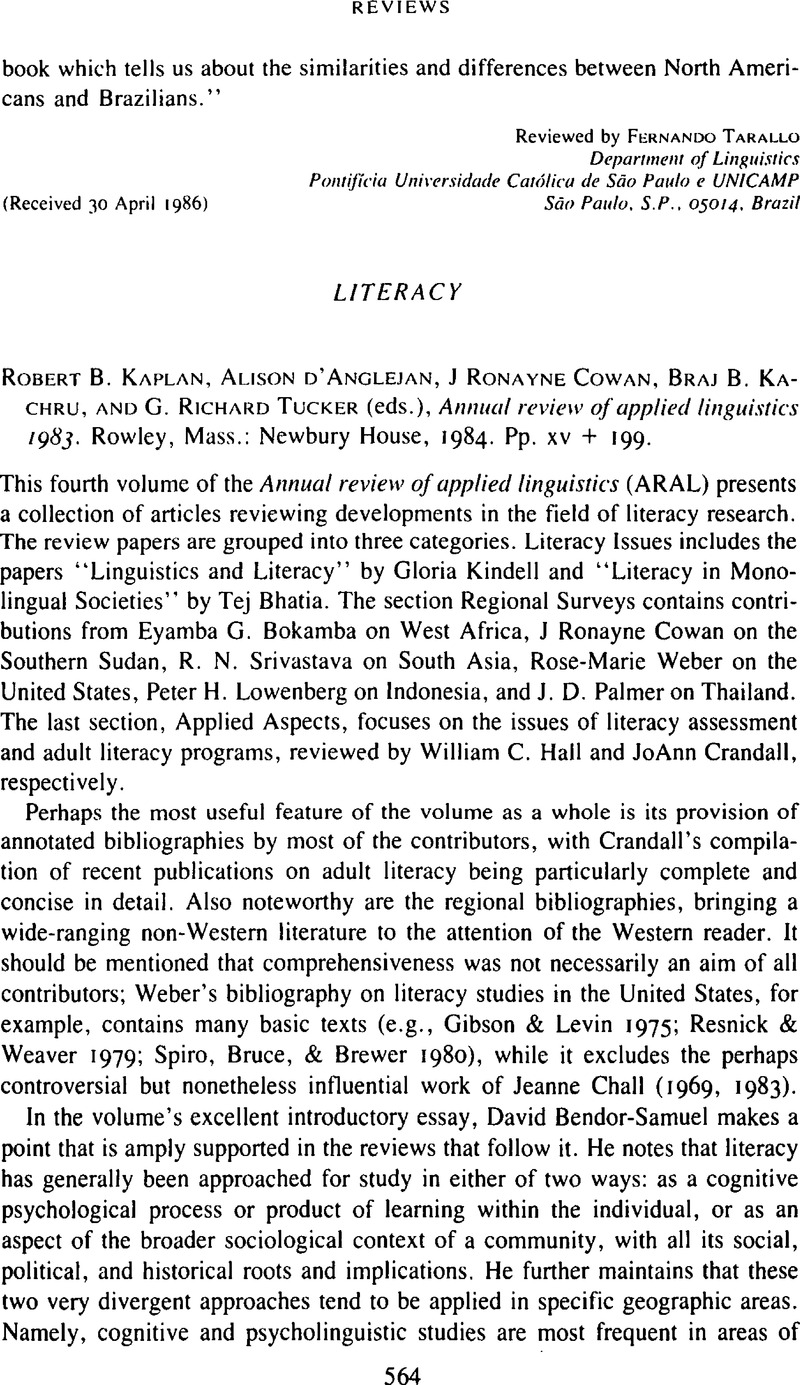No CrossRef data available.
Article contents
Literacy - Robert B. Kaplan, Alison d'Anglejan, J Ronayne Cowan, Braj B. Kachru, and G. Richard Tucker (eds.), Annual review of applied linguistics 1983. Rowley, Mass.: Newbury House, 1984. Pp. xv + 199.
Published online by Cambridge University Press: 18 December 2008
Abstract
An abstract is not available for this content so a preview has been provided. Please use the Get access link above for information on how to access this content.

- Type
- Book Review
- Information
- Copyright
- Copyright © Cambridge University Press 1986
References
REFERENCES
Downing, J. (ed.) (1973). Comparative reading: Cross-national studies of behavior and processes of reading and writing. New York: Macmillan.Google Scholar
Feitelson, D. (ed.) (1978). Cross-cultural perspectives on reading and reading research. Newark, Del.: International Reading Association.Google Scholar
Gibson, E. J., & Levin, H. (1975). The psychology of reading. Cambridge, Mass.: MIT Press.Google Scholar
Havelock, E. A. (1974). Origins of Western literacy. Toronto: Ontario Institute for Studies in Education.Google Scholar
Heath, S. B. (1980). The functions and uses of literacy. Journal of Communications 30:123–33.CrossRefGoogle Scholar
Heath, S. B. (1982). What no bedtime story means: Narrative skills at home and school. Language in Society 11:49–76.CrossRefGoogle Scholar
Heath, S. B. (1983). Ways with words: Language, life, and work in communities and classrooms. Cambridge University Press.CrossRefGoogle Scholar
Hudelson, S. (ed.) (1981). Learning to read in different languages. Washington, D.C.: Center for Applied Linguistics.Google Scholar
McDermott, R. P. (1974). Achieving school failure: An anthropological approach to illiteracy and social stratification. In Spindler, G. D. (ed.), Education and cultural process: Toward an anthropology of education. New York: Holt, Rinehart, & Winston. 82–118.Google Scholar
McDermott, R. P. (1977). The cultural context of learning to read. In Wanat, S. (ed.), Issues in evaluating reading. Washington, D.C.: Center for Applied Linguistics. 10–18.Google Scholar
Resnick, L. B., & Weaver, P. A. (eds.) (1979). Theory and practice of early reading. Hillsdale, N.J.: Lawrence Erlbaum.Google Scholar
Schuman, H., Inkeles, A., & Smith, D. (1967). Some social psychological effects and noneffects of literacy in a new nation. Economic Development and Cultural Change 16:1–14.CrossRefGoogle Scholar
Scribner, S., & Cole, M. (1978a). Unpackaging literacy. Social Science Information 17:19–40.CrossRefGoogle Scholar
Scribner, S., & Cole, M. (1978b). Literacy without schooling: Testing intellectual effects. Harvard Educational Review 48:448–61.CrossRefGoogle Scholar
Scribner, S., & Cole, M. (1981). The psychology of literacy. Cambridge, Mass.: Harvard University Press.CrossRefGoogle Scholar
Spiro, R. J., Bruce, B. C., & Brewer, W. F. (eds.) (1980). Theoretical issues in reading comprehension: Perspectives from cognitive psychology, linguistics, artificial intelligence, and education. Hillsdale, N.J.: Lawrence Erlbaum.Google Scholar
Stevenson, H. W., Stigler, J. W., Lucker, G. W., & Lee, S. (1981). Reading disabilities: The case of Chinese, Japanese, and English. Cognitive Science. Technical Report No. 31.Google Scholar
Sticht, T. G. (1977). Comprehending reading at work. In Just, M. & Carpenter, P. (eds.), Cognitive processes in comprehension. Hillsdale, N.J.: Lawrence Erlbaum.Google Scholar
Thorndike, R. L. (1973). Reading comprehension in fifteen countries: An empirical study. (International Studies in Evaluation III.) New York: Wiley.Google Scholar




